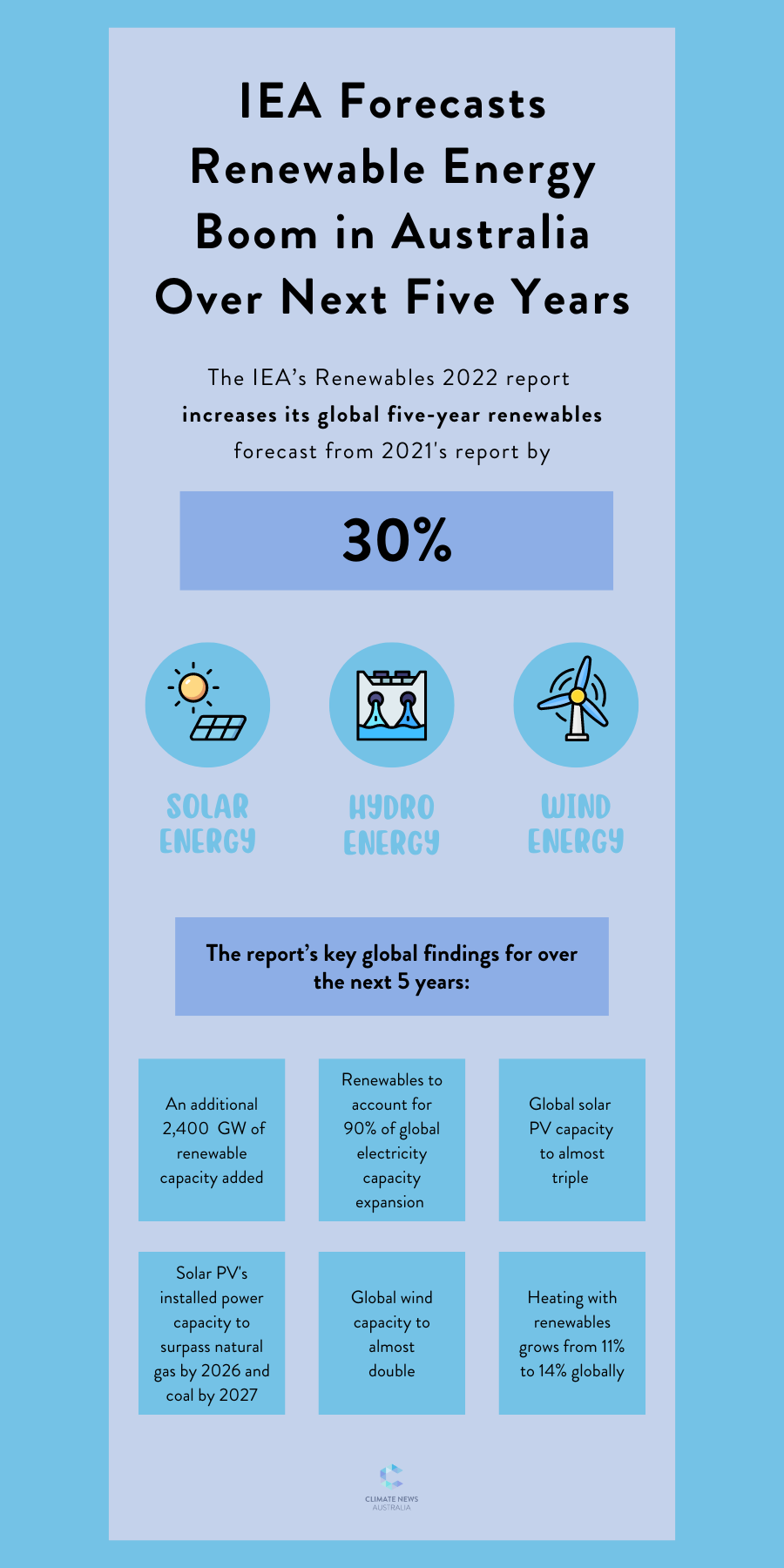Renewable energy capacity in Australia will almost double in the next five years, according to a new report from the International Energy Agency (IEA). This outlook is on par with the global forecast and would result in renewables overtaking coal as the largest source of electricity generation by early 2025. This sharp acceleration in the clean energy transition helps to keep the possibility of limiting warming to 1.5°C alive, the report finds.
The IEA’s ‘Renewables 2022′ report increases its global five-year renewables forecast by 30 per cent from 2021’s report. This comes in the wake of the fossil fuel supply crunch that was triggered by Russia’s invasion of Ukraine. The ensuing global energy crisis is the driving force behind the “unprecedented momentum” in renewable power installations, the report highlights. This supports the IEA’s World Energy Outlook 2022 released in November, which found that the peak use of fossil fuels is imminent. Demand will plateau and then decline steadily from the mid-2020s as renewable deployment accelerates, its modelling found.
“Renewables were already expanding quickly, but the global energy crisis has kicked them into an extraordinary new phase of even faster growth as countries seek to capitalise on their energy security benefits. The world is set to add as much renewable power in the next 5 years as it did in the previous 20 years”, said Fatih Birol, IEA Executive Director. “This is a clear example of how the current energy crisis can be a historic turning point towards a cleaner and more secure energy system. Renewables’ continued acceleration is critical to help keep the door open to limiting global warming to 1.5°C.”
Renewables 2022: Key global findings
The main forecast in the IEA’s report predicts a rapid acceleration of the clean energy transition between 2022 and 2027. However, the pace differs significantly between countries. Moreover, gains in clean electricity generation will outpace heating and transport. The report’s key global findings for over the next five years are:
- An additional 2,400 gigawatts (GW) of renewable capacity to be added, equal to the entire installed power capacity of China today
- Renewables to account for over 90 per cent of global electricity capacity expansion
- Global solar photovoltaic (PV) capacity to almost triple
- Solar PV’s installed power capacity to surpass natural gas by 2026 and coal by 2027
- Global wind capacity to almost double, with offshore projects accounting for one-fifth of the growth
- China, the United States and India to account for two-thirds of this global growth in renewable capacity expansion
- Heating with renewables to grow from 11 per cent to 14 per cent globally (this is not fast enough to contain fossil fuel use)
The report also outlines an accelerated model, which indicates that global renewable capacity can expand by a further 25 per cent compared with the main forecast. That is if countries address policy, regulatory, permitting and financing challenges. This would narrow the gap to net zero by 2050.
The renewable energy outlook in Australia
For Australia, the IEA revised its latest renewable energy forecast upwards by over 30 per cent from last year’s outlook. This reflects the announcement of new renewables auctions and the continued corporate power purchase activity (PPA) for governments, utilities and businesses. New projects associated with renewable energy zones (REZs) are also driving this acceleration.
According to the report’s main forecast, the key findings for the next five years in Australia are:
- Close to 40 GW of renewable energy capacity to be added, representing an increase of more than 85 per cent
- Distributed PV deployment to expand the most of all the renewable technologies, although grid fees and system costs impair its full growth potential
- State-level targets and PPAs to propel the expansion of utility-scale renewables
In line with the global outlook, the IEA’s accelerated case for Australia also forecasts almost 25 per cent higher additions than the main case. This would require more state-level auctions and faster-than-expected commissioning of REZs. Furthermore, additional coal-fired plant retirements would accelerate new large-scale renewable energy and battery storage installations. New wind and solar PV capacity associated with green hydrogen could also add a further six GW of additional capacity, the report finds.
The IEA’s outlook for Australia corroborates an earlier report from the Australian Energy Market Operator. The agency’s June 2022 report found that Australia’s net zero transition is accelerating faster than expected, driven by early coal retirements and rapidly falling costs of renewables. This is great news for climate action, job creation and lower bills. “The adoption and transition of renewables will bring immense opportunity to Australians in terms of creating jobs, lowering emissions and ensuring security to our power supply”, said Tim Baxter, Climate Council Senior Researcher. “This transition is essential to protecting Australian lives.”

